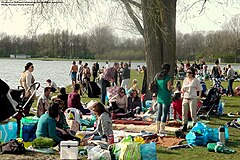Sizdah Be-dar
| Sizdah Bedar | |
|---|---|
 Iranians in the Netherlands celebrating Sizdah Be-dar, April 2011 | |
| Observed by | |
| Celebrations | Picnicking outdoors |
| Date | April 1 or 2 |
| Frequency | annual |
| Related to | Nowruz, Charshanbe Suri |
Sizdah Bedar (Template:Lang-fa – Sizdebedar),[1][2] also known as Nature's Day (روز طبیعت – Ruz e Tabi'at),[3] is an Iranian festival held annually on the thirteenth day of Farvardin (the first month of the Iranian calendar), during which people spend time picnicking outdoors.[1] It marks the end of the Nowruz holidays in Iran.[4]
Observances
Sizdah Be-dar is celebrated on the thirteenth day of Nowruz, the Iranian New Year. It is celebrated by leaving houses to join nature, and spending the day outdoors.
In Iranian Azerbaijan, it is called Sinzə Günü which means the "thirteenth day."
Throwing away the greenery

A ritual performed at the end of the picnic is to throw away the greenery ([سبزه – Sabze] Error: {{Lang}}: text has italic markup (help)) collected for Haft-Seen, the customary setting of Nowruz in Iran. Touching someone else's greenery on this day or bringing it back home is considered a bad omen.
Knotting the greenery
It is also customary for young single people, especially young girls, to tie the leaves of the greenery before discarding it, expressing a wish to find a partner.
Chahardah Be-dar
Chahardah Be-dar (Template:Lang-fa) is the fourteenth day of Nowruz, which is celebrated only in Lorestan Province. Lurs stay home on the thirteenth day of Nowruz, referred to as the Strange Thirteen ([سیزده غریب – Sizdah e Qarib] Error: {{Lang}}: text has italic markup (help)) by them. Instead, they picnic outdoors a day after Sizdah Be-dar.
External links
- Sizdah-Bedar in Delft (Netherlands) on YouTube (Video)
- Animation about Sizdah-Bedar on YouTube (Video)
See also
References
- ^ a b Shahbazi, A. Shapur. "NOWRUZ ii. In the Islamic Period". Encyclopædia Iranica. Retrieved 8 January 2012.
- ^ Mosaheb, Gholamhossein, ed. (2002) [1966]. "سیزدهبدر" [Sizde be.dar]. The Persian Encyclopedia (in Persian). Vol. 1 (2nd ed.). Tehran: Amirkabir. p. 1404. ISBN 964303044X.
- ^ "Iranians mark Sizdah Bedar in nature". Press TV. 1 April 2016.
- ^ "Iranians mark Sizdah Bedar in nature". mypersiankitchen. 2 April 2010.
